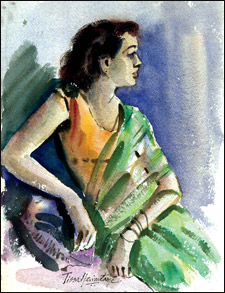Painting human figure in water-colour
Tissa Hewavitarane
Various artists use a variety of styles and techniques in approaching
the painting of people in water-colour. Wash drawings, loose painting,
careful studies, sketchy drawings, design concepts, and casual likeness
are all proper techniques. Some artists like to emphasize the human
figure and even paint portraits in water-colour. Water colour portraits
or figure paintings offer an exciting challenge. This painting is done
from a photograph titled ďlady in sarieĒ.
|

Water-colour portrayal of a woman |
I have put down colours boldly and quickly working from light wash to
dark. The photograph was used as a reference for values, shapes, and
light.
Copying from photographs
To many teachers the word ďphotographĒ is questionable and doesnít
belong in the artistís vocabulary. But, if the artist remembers that he
is creating a painting and not another photograph, then the photographs
can provide a lot of subject matter. Magazines, various photographs and
slides can provide lot of subject matter without painting outdoors.
Unlike in other countries in Sri Lanka it is impossible for a person to
pose for a portrait. Time and distance preclude such opportunities.
Therefore, select from the photograph as from nature, the principal
parts of the composition. Donít try to include everything. Keep it
simple.
Make the sketch from the photograph and donít refer to it again
except to check values and characteristic detail.
Photograph, can provide valuable information regarding form, light,
texture and value. Just remember to use it as information and not
something to be copied exactly.
Keep it simple
Applying several techniques is essential to understanding transparent
watercolour. The paint can be applied to dry papers or to wet.
Dry sheets lend themselves to line work, dry brush and a variety of
washes, while damp sheets are necessary in using wet-in-wet-techniques.
Donít overwork the surface! Donít add too many details! Donít apply too
many washes over each other, or muddiness will result. Water colours
generally work best when kept simple.
Painting human figure in watercolour
Figure painting in water colour has a reputation for being difficult,
if not down wright impossible. But, as so often happens in water colour,
the biggest difficulties usually arise from the artistís lack of
confidence and an unwillingness to let go and allow the medium its
fullest expression. Learn to enjoy the fluid and mercurial qualities of
water colour - qualities that make it ideal for depicting the subtle
lines and curves of the human form and the play of light upon its
surfaces. The best watercolour portraits are not ďposedĒ at all but are
painted on the spur of the moment, perhaps when the subject happens to
be relaxing in an armchair or strolling in the garden.
No boundaries
One habit that should be dropped like a hot potato is that of drawing
a rigid out line of the figure and filling it in with colour. This kills
any feeling of life and movement in the figure and effectively cuts it
off from the background so that it looks like a cardboard cut-out. By
all means make a few light pencil marks to plot the position of the
figure, but donít treat them as boundary lines that canít be crossed;
nothing should be allowed to inhibit the speed and flow of your washes.
Keep it fluid
If you work in a dry and sparing manner, with timid brushestrokes and
a brush that is starved of paint, itís not surprising if the finished
result looks lifeless. Always use as large a brush as you dare, to
discourage fiddly strokes, and load it with plenty of pigment. It is
always good to work on damp paper; this makes it easier to lift out
colour for highlights, or to wipe out mistakes. It also means that your
colours can flood into each other wet-into-wet creating subtle,
translucent skin tones.
Depth and colour
Water colour proves the simplicity can be solid base for a painting.
The secret of success in painting in great part, lies in knowing when to
stop, only painting what is necessary. This painting proves the forms of
applying colours, and how the most transparent layers work on the white
of the paper and the superim position of brushstrokes with the
background. The colour of the skin is shown with a light wash of light
red with a mixture of burnt sienna. The base colour of the hair is burnt
sienna, enhanced by orange.
The dress is painted in successive layers of orange and red always
very transparent, respecting the parts that contains the highlights. The
creases of the saree is are painted with firm brush strokes. The
background is painted with a very transparent ultramarine and windsor
violet to give more depth with dark brush strokes. It must be emphasised
that the object of this painting is above all, to interpret the
techniques of painting human figure in water colour.
Points to remember
. In all water colour work, the initial drawing is a vital guide so
that later developments find a good structure into which to fit.
. Using high quality paper is very important because with ordinary
paper merging colours is practically impossible once the colour has
dried.
. When putting down layers on the background, it is always prudent to
start with the lightest tones and then, afterwards, if necessary, to
intensify them progressively with successive layers of colour.
. The drawing is the foundation of water colour painting. It is used
as a guide as to where to apply the various tones or colours. Therefore
it is essential that the artist draw the lines correctly before starting
to paint.
www.tissahewavitarane.com |



